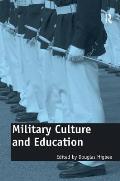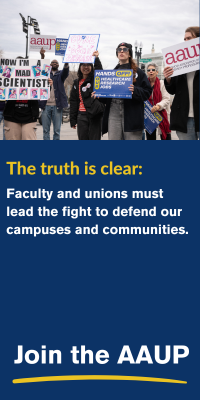- About
- Programs
- Issues
- Academic Freedom
- Political Attacks on Higher Education
- Resources on Collective Bargaining
- Shared Governance
- Campus Protests
- Faculty Compensation
- Racial Justice
- Diversity in Higher Ed
- Financial Crisis
- Privatization and OPMs
- Contingent Faculty Positions
- Tenure
- Workplace Issues
- Gender and Sexuality in Higher Ed
- Targeted Harassment
- Intellectual Property & Copyright
- Civility
- The Family and Medical Leave Act
- Pregnancy in the Academy
- Publications
- Data
- News
- Membership
- Chapters
Permission to “Engage”?
Military Culture and Education. Douglas Higbee, ed. Burlington, VT: Ashgate, 2010.
The recent debate over the status of the Reserve Officer Training Corps (ROTC) at elite universities is winding down in the wake of decisions by Harvard, Columbia, Yale, and Stanford to welcome ROTC back to campus for the first time since it was expelled during the Vietnam War. The rush of these institutions to reinstate on-campus ROTC programs after the repeal of “Don’t Ask, Don’t Tell,” along with the anemic level of protest on the part of students and faculty, demonstrates that critiques of campus militarization that circulated widely in the 1960s and 1970s have given way to a celebration of “engagement” and “dialogue” between the military and higher education.
The essays in Military Culture and Education, described by editor Douglas Higbee as a collective effort to “bridge the gap between the academy and the military,” are important for those contemplating the merits of this “engagement” framework. Many of the contributors have feet in both camps, and most of the selections argue in favor of engagement as a viable and underutilized approach to achieving progress inside both the military and the university. Higbee organizes the essays according to the institutional location of the authors, but readers interested in thinking through the promise and pitfalls of the trend toward a more tightly integrated military-academic complex will find it more productive to group them according to how the authors conceptualize engagement between the military and academia.
The first and most uncontroversial set of essays frames engagement in terms of the professional challenges and rewards of doing scholarly work on the military’s turf. Historian Daniel J. Hughes, who taught for eighteen years at the Air War College, provides a painfully candid reflection on the pervasive indifference of his students to genuine intellectual inquiry. A less cynical exchange between Karen Pierce and Major David C. Wood, both of whom taught in the English Department at the United States Military Academy at West Point, dispels visions of the service academies as simple indoctrination factories while cautioning that military academy culture can sometimes impede scholarly work in the humanities. Thomas Bruscino, a historian at the US Army School of Advanced Military Studies at Fort Leavenworth, views his efforts to supplement senior officers’ professional knowledge with academic expertise as a challenging but gratifying endeavor. As a whole, the essays in this category will prove useful for academics contemplating employment at service academies or military postgraduate schools.
The essays in the second group all argue, in one way or another, for the progressive potential of engagement between universities and the military. Several make impassioned arguments for the ability of academics teaching at military institutions to dent the armor of military cultures still plagued by regressive social practices and an aversion to critical thinking. For example, Huw Osborne, who teaches English at the Royal Military College of Canada, identifies provocative strategies for applying queer theory in the service-academy classroom in order to raise consciousness about homophobia. Andrea Trocha-Van Nort and Bradley Carter likewise offer insightful, if slightly more orthodox, thoughts on how those teaching on military turf can meaningfully shape their students’ intellectual development. Some readers will take issue with these authors’ assumption that the progressive remodeling of military institutions can be accomplished simply by molding officers with better critical-thinking skills. And, indeed, it seems like a stretch to expect a few years of liberal learning in humanities classrooms at service academies to counter the professional indoctrination officers face in the remainder of their careers in the field or fleet.
More problematic, however, are the pieces in this second group of essays that argue for an expansion of the military’s role on civilian campuses or of the role of civilian academics in the design of American wars. These selections assume that the military and civilian university can meet on equal footing in some sort of symbiotic institutional relationship. Edward Palm, a retired Marine Corps officer and former Naval Academy English instructor, argues, for example, that the solution to the problem of training cadets and midshipmen in the humanities in the otherwise authoritarian culture of the service academies is to deemphasize the service academies and expand the role of ROTC in officer training. Universities, he believes, should welcome this change “as an opportunity for constructive engagement and mutual understanding.” But even at civilian academic institutions without ROTC, liberal learning and critical thinking have long been under siege as a consequence of the economic, cultural, and political power of the American military, and higher education funding continues to be dwarfed by an out-of-control defense budget. Universities depend on the Department of Defense for what now amounts to billions of dollars in funding each year. The military and ROTC also enjoy the full support of the state in their efforts to entrench themselves on university campuses, and the Solomon Amendment gives the government the power to suspend federal funding to universities that reduce or refuse to expand their relationship with military recruiters and officer-training programs. The choice of whether to engage lies, in other words, squarely in the lap of the military.
The crucial issue of state power also goes unaddressed in Carol Burke’s discussion of her experience while embedded with a “human terrain team” in Iraq. She concludes that the increased involvement of academics “in the planning and implementation of [Department of Defense] projects” could lead to a more socially responsible American war-fighting model. Yet this putatively expanded engagement limits academics to making wars already initiated by the state more palatable; it does not allow them to influence whether the United States goes to war. Add to the military’s political and economic influence a larger American culture that, according to historian and retired Army officer Andrew Bacevich, is “enthralled with American military power” to an unprecedented extent, and a level playing field between the military and the academy seems unimaginable. Nonetheless, articles like those by Palm and Burke raise an important question: does engagement aptly describe a situation in which one party is pressed—by popular ideology, state power, and economic dependence—to “engage” with another?
The third group of essays argues that American cadets and midshipmen uniquely embody the values of civic participation and democratic discourse. Authors in this group believe that engagement between academics and officers-in-training more closely approximates the ideal of liberal learning than professors’ interactions with civilian students and, further, that service-academy classrooms provide some of the richest opportunities for progressive scholars to put this ideal into practice. D. Alexis Hart, a naval officer and professor of writing at the Virginia Military Institute, suggests that “VMI’s claims about educating students to be active participants in the democratic process have more credibility than similar pronouncements at other institutions,” because the cadets there are selfselected for a career that sacrifices personal enrichment for the sake of the greater good. Jeffrey Sychertz, a Naval Academy graduate and English PhD, similarly contends that students decide to matriculate at service academies out of “precisely the same sense of service” that leads academics in the humanities to choose a “career of sacrifice and service over one of profit.” Perhaps many cadets and midshipmen share an abstract commitment to the “greater good,” but they also serve for wages, benefits, and economic stability increasingly rare in the civilian world. While the military may appear in American popular ideology as the last credible civic institution, many officers and enlisted personnel explain their service not as a commitment to the greater good but rather as a way to avoid unemployment or underemployment on the outside.
Hart and Sychertz’s intentions are admirable, but conceiving of the current military as the vanguard of democratic consciousness is misguided. If educators hope to help young people create and sustain new institutions from which genuinely democratic thought and action can emerge, they need to take part in a more historically and sociologically informed conversation about the stakes of engagement with the military. The thoughtful, if overly sanguine, contributions to Military Culture and Education deserve careful consideration; they signal the urgency of beginning this conversation.
Sean Dinces is a graduate of the US Naval Academy and a doctoral candidate in American studies at Brown University. His e-mail address is [email protected].




